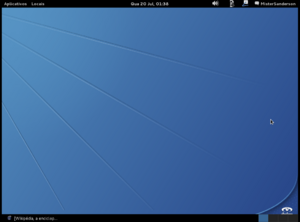GNewSense facts for kids
 |
|

gNewSense 4.0
|
|
| Company / developer | Current: Matt Lee former: Sam Geeraerts, K.Goetz, Brian Brazil and Paul O'Malley |
|---|---|
| OS family | Linux (Unix-like) |
| Working state | discontinued |
| Initial release | November 2, 2006 |
| Latest stable release | 4.0 |
| Latest unstable release | 4.0 Alpha 1 / 2 December 2014 |
| Update method | long term support |
| Package manager | apt (standard), Synaptic (Gtk+ frontend), dpkg (low-level system) |
| Supported platforms | amd64, i386, Loongson |
| Kernel type | Monolithic (Linux) |
| Userland | GNU |
| Default user interface | GNOME |
| License | FSDG |
gNewSense was a special type of computer operating system. It was a Linux distribution, which is like a version of the Linux operating system. It was active from 2006 to 2016.
This system was based on another popular Linux version called Debian. The Free Software Foundation helped support its creation. The main goal of gNewSense was to be easy for users to understand. It also aimed to remove all proprietary software. This means it had no software that was owned by a company and had rules about how you could use it. It also removed things like binary blobs, which are small pieces of code that help hardware work but are not "free" to use or change.
The Free Software Foundation believed gNewSense was made completely of free software. This means anyone could use, study, change, and share it. gNewSense was very strict about this. For example, it would not include any instructions on how to install software that was not free.
The last version of gNewSense was released in 2016. It has not been updated or supported since 2018. Websites that track operating systems now say gNewSense is "discontinued."
Contents
The Story of gNewSense
The gNewSense project started in 2006. It was created by Brian Brazil and Paul O'Malley. At first, gNewSense was based on another Linux system called Ubuntu. When the first version, 1.0, came out, the Free Software Foundation started helping the project.
For two years, there were no new versions of gNewSense. Because of this, in 2011, a website called DistroWatch said gNewSense was "dormant," meaning it was not active. But by September 2012, DistroWatch changed its status back to "active."
On August 6, 2013, a new version called gNewSense 3 "Parkes" was released. This version was directly based on Debian, not Ubuntu. There have been some hints that the project might start again. For example, there was an announcement on its website in 2019. However, the project has stayed inactive, with no new releases since 2016. DistroWatch changed its status to "dormant" again in 2019. By 2022, it was listed as "discontinued."
For a short time in 2021, the gNewSense website showed a blank page with an internet meme. After that, it sent visitors to the website for PureOS, another free operating system. However, since June 2021, the website now sends people to the Free Software Foundation's list of free Linux systems.
How gNewSense Worked
By default, gNewSense used a desktop environment called GNOME. This is the way the computer screen looks and how you interact with it. Users could change how their computer looked. They could choose different X display managers or window managers. Other desktop environments could also be installed from its software libraries.
gNewSense used an installer called Ubiquity. This tool allowed users to install the operating system onto their computer's hard drive. They could do this directly from a Live CD. A Live CD lets you try out the operating system without installing it first.
Besides the basic tools, gNewSense came with several programs. These included the LibreOffice suite for documents and spreadsheets. It also had GNOME Web for browsing the internet. For chatting, it had Empathy. For editing pictures, it included GIMP. Tools for software development, like the GCC, were also installed by default.
Installing gNewSense
You could use a Live CD to run gNewSense without installing it. This CD also allowed you to install the system onto your computer's hard drive. You could download these CD images to create your own Live CD.
Different Versions of gNewSense
gNewSense had four main versions released over time:
| Version | Code name | Release date | Supported until | Based on | Supported computers |
|---|---|---|---|---|---|
| 1.0 | DeltaD | 2006-11-02 | 2008-05-01 | Ubuntu 6.06 "Dapper Drake" | Not specified |
| 2.0 | DeltaH | 2008-04-30 | 2014-01-03 | Ubuntu 8.04 "Hardy Heron" | Not specified |
| 3.0 | Parkes | 2013-08-06 | 2015-12-31 | Debian 6.0 "Squeeze" | i386, amd64, Lemote Yeeloong |
| 4.0 | Ucclia | 2016-05-02 | 2018-05-31 | Debian 7 "Wheezy" | i386, amd64, Lemote Yeeloong |
In 2016, gNewSense announced that the next version would be 5.0. However, it was never released.
What Made gNewSense Different
gNewSense was very strict about only using free software. It did not offer any software libraries that contained non-free programs. It also removed most non-free documents and artwork.
When gNewSense was based on Ubuntu, it changed the name of the Mozilla Firefox web browser to "BurningDog." This was to avoid problems with trademarks. BurningDog also did not offer to install non-free plugins for things like Adobe Flash. Later, gNewSense 2.0 stopped using BurningDog. It started using the Epiphany web browser (now just called "Web") as its main browser. gNewSense 3.0 kept Web as the default browser. It also included a changed version of Debian's Iceweasel. This version did not offer access to any non-free add-ons.
Debian is another Linux system known for its strict rules about free software. Both Debian and gNewSense carefully removed non-free software from their main versions. However, Debian also kept unofficial places to get non-free software and firmware. Debian believed users should decide if they wanted to use such software. gNewSense, on the other hand, did not provide any programs that needed or suggested using non-free software. It also did not make it easy to get proprietary software. This was because gNewSense was fully committed to developing only free software solutions.
gNewSense was first created from Ubuntu. Ubuntu itself was originally created from Debian. But starting with gNewSense 3.0, the system began to use Debian as its main base. This was partly because Debian carefully separated its free software from the proprietary software it offered. Many programs from Debian were changed for gNewSense. These changes made sure they no longer offered access to non-free software options.
Limitations of gNewSense
Because gNewSense only used free software, it had some limitations. It could not support all computer hardware. For example, some wireless network cards need special software called firmware to work. If no free firmware was available for that hardware, gNewSense could not support it.
Also, for a time, 3D graphics support was removed from gNewSense. This was due to licensing issues with Mesa 3D. However, these issues were fixed. By January 2009, 3D support became standard again starting with the 2.2 release.
See also
 In Spanish: GNewSense para niños
In Spanish: GNewSense para niños
- Comparison of Linux distributions
- List of distributions based on Debian
- GNU/Linux naming controversy


